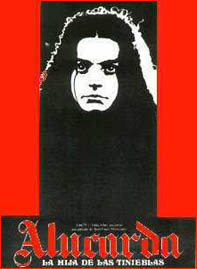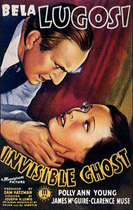Our editor-in-chief Nate Yapp is proud to have contributed to the new book Hidden Horror: A Celebration of 101 Underrated and Overlooked Fright Flicks, edited by Aaron Christensen. Another contributors include Anthony Timpone, B.J. Colangelo, Dave Alexander, Classic-Horror.com's own Robert C. Ring and John W. Bowen. Pick up a copy today from Amazon.com!
Alucarda (1975)
It’s impossible to get a bead on Juan Lopez Moctezuma’s Alucarda. There are no clear-cut heroes or villains; nearly every character seems monstrous at one point or another. The film hops from one protagonist to the next, condemning each in turn. A dichotomy between reason and the supernatural, standard to many horror films, is established, and then banished. Scenes that would seem to be filtered through the subjective viewpoints of the characters are then presented as objective events, while objective events take on the skewed reality of a subjective viewpoint. Alucarda exists in a gestalt world where fact and fantasy overrun each other, where evil can only be overcome by evil, and where freedom and repression are both paths to destruction.
Alucarda begins like a supernatural version of Heavenly Creatures. Justine (Susana Kamini) arrives at the convent after the deaths of her parents, and quickly befriends her roommate, the vivacious but disturbed Alucarda (Tina Romero). The two fall into a bizarre, codependent relationship, with Alucarda clearly dominating Justine (whose name is a reference to De Sade’s heroine). To seal their bond, Alucarda calls on Satan, and the girls are inducted into the service of the devil.
Or are they? Their initiation is full of contradictions and surreal moments. The officiator is a hunchbacked gypsy (Claudio Brook) who appears suddenly from the shadows and hands Alucarda a knife that she was shown to have in her possession earlier in the film. He calls for thunder and lightning and the camera moves to the window to show us the compliant weather. When it comes back, Alucarda hasn’t moved, but her clothing has vanished. After a ceremonial sharing of blood, Alucarda and Justine are lead to a field where Satan’s congregation engages in an orgy. This scene’s reality is suspect, as we somehow see it through the perspective of Justine’s friend Sister Angelica, even though she is miles away at the convent. She is praying for the girls' souls and, in her religious fervor, strikes down one of the gypsies with the power of her mind. At no point in the film do the girls discuss this sudden, inexplicable death, and the orgy may be the righteous hallucination of a nun too devoted to her charges. However, if neither sequence is real, then much of the rest of the film doesn’t make sense, as I’ll explain a little later.
Alucarda’s strangeness continues when, at a Bible lesson, the girls begin recounting blasphemies. Soon after, Alucarda attempts to grope Father Lazaro (David Silva) during confession. This encroachment of “evil” upon Lazaro’s convent leads him to call for the girls’ exorcisms. Justine and Alucarda are strapped to upstanding racks in a visual mockery of the crucifixion. Justine is stripped naked, ostensibly to look for a non-existent “mark of the devil”, and then stabbed repeatedly with a long needle. Dr. Oszek (Claudio Brook again), a rational physician who had been treating Justine for a mysterious illness, interrupts the ceremony, but Justine has already died. Oszek carries Alucarda away, condemning the congregation for their barbaric superstitions.
Oszek is important because his presence invalidates any purely subjective reading of the film. He is originally presented to us as a wise man of science, a trustworthy source of the objective truth. After he discovers that Justine has died of her exorcism wounds, he lays into Father Lazaro with a vicious verbal attack. We are clearly meant to agree with, and sympathize with, Oszek’s viewpoint. After all, in an earlier scene, we witness Lazaro and the nuns undergo a bloody round of flagellation. The religious in Alucarda are clearly deranged, and Oszek is a reassurance that the real world doesn’t hold with concepts like demonic possession. Later, however, Oszek clearly observes events that no science can explain, including Justine’s bloody resurrection and Alucarda’s vengeful pyrokinesis. If those events happen, as Oszek’s pseudo-objective viewpoint suggests they must, then the girls must have made some connection to the supernatural earlier in the film. Reality retroactively rushes in to meet the unreality of those previous sequences, and we must accept that there is no way to interpret anything in Alucarda purelyin terms of dream or reality. What happens happens; the truth or untruth of it is none of our concern.
The characters in Alucarda are as ambiguous as its events. There are heroes and there are villains, but they tend to be the same people. Any person presented as a hero, either in his or her own eyes or in the objective “eyes” of the film, is also a monster. Alucarda rescues Justine from the grief of losing her parents by presenting her to Satan, and then avenges her death by setting nuns on fire. Father Lazaro’s righteous stand against evil involves torturing a 15-year-old girl to death. Dr. Oszek, who renounces science in favor of religion when presented with incontrovertible evidence of the supernatural, takes his time dispatching one of the devil’s minions while ignoring a nun who is bleeding to death nearby. Even Sister Angelica, typically presented as a kind, thoughtful soul, wears a beatific expression after her long-distance murder of the gypsy woman. All acts of righteousness are also wicked. The film has no moral center because morality is a construct practiced by the reprehensible.
The refusal to recognize comfortable dichotomies like good/evil, fantasy/reality, supernatural/rational, and objective/subjective is often an accidental effect of haphazard films put together by grossly untalented directors (William Girdler’s Asylum of Satan comes to mind). In Alucarda, however, it is clear that Moctezuma is carefully guiding the entire experience. Every shot, every edit is exercised with precision. For instance, Moctezuma establishes a cinematic pattern early in the film. When we follow the girls as they play outside or when they are taking part in devilish acts, the camera is free, roaming, and the editing feels improvised. Inside the convent, the framing is more structured, and the edits are measured and utilitarian. Moctezuma later subverts this by using his “outside” techniques inside the convent in the scene where the girls recite blasphemies at their teacher. The dangerous freedoms of the exterior have punctured the interior of the convent, but, again, we have to ask if the camera is relaying the subjective experience of the girls’ heady defiance or if we’re being let in on the objectively true, tangible entry of an evil force. Moctezuma provides no answers; he seem to prefer it that way.
Moctezuma juxtaposes sex and violence in ways that twists their separate appealing and appalling aspects together until they are indistinguishable. Particularly striking is the image of the undead Justine rising from a blood-filled coffin, her eyes wide and unearthly, her naked body soaked in crimson. It’s a horrifying sight, but also a sensual one… there’s something perversely sexy about this resurrected girl. Also hypnotic in its repugnance is the scene of the nuns being whipped. We have seen them in non-traditional habits that look like mummy gauze, with only their exposed faces betraying their humanity. Here, as they seek to drive out evil with pain, we catch sight of their skin for the first time, covered in bloody red gashes. The revelation of skin is sexual, the accompanying violence is sickening, and the fact that the pain is consensual brings a mixture of revulsion and attraction.
There are a number of elements in Alucarda that I have not touched upon – the spectacular production design, the heavy religious symbolism, the extreme amounts of blood and nudity – that could sustain a separate essay of equal length. However, I’ve chosen to cover what I find to be the most fascinating part of Alucarda: Moctezuma’s steadfast refusal to adhere to boundaries that horror film fans (and, in fact, most cinema-goers) take for granted. By taking away the signposts that give us comfort, he creates a nightmare vision that defies interpretation and definition. Well, actually, there is one definition that sticks: “disturbing.”









great review! this is one of
great review! this is one of my favorite films!